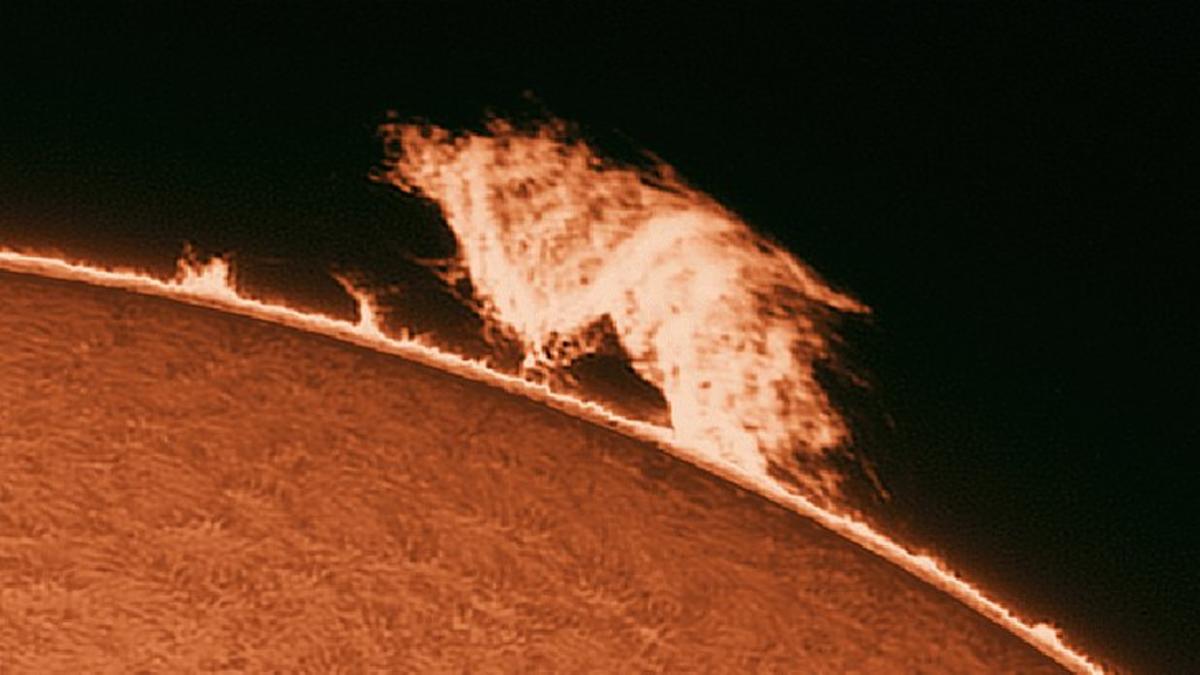Article Body
A Solar Serpent Slithers: The Beast Awakens on the Sun
At 3:17 AM UTC on July 13, solar telescopes lit up across observatories from Hawaii to Heidelberg. Amateur astronomers gasped. On the Sun’s northeastern limb, something massive, bright, and curling like a galactic tentacle erupted—a magnetic loop of gas spanning thousands of kilometers.
Nicknamed “The Beast”, this prominence writhed like a cosmic dragon tail, captivating skywatchers and experts alike. The raw, ferocious power of the Sun—up close, alive, and unpredictable—was on full display.
“We’ve never seen a structure this dynamic move so rapidly and with such complexity,” said Dr. David Wills, solar physicist at the European Space Agency. “It’s like the Sun is flexing its muscles before solar max.”
Why This Matters Now: The Sun Is Near Its Peak Fury
This event didn’t happen in a vacuum—literally or figuratively. We’re nearing Solar Cycle 25’s peak, forecast for late 2024 to mid-2025, when sunspot numbers, solar flares, and coronal mass ejections (CMEs) are at their most frequent and intense.
Google Trends data for “Sun activity today,” “solar flare danger,” and “northeastern solar limb” spiked over 300% globally on July 13, especially in the U.S., India, and parts of Europe.
This isn’t just a pretty light show for telescope buffs. Such prominences can precede geomagnetic storms—like the one in May 2024 that temporarily disrupted Starlink satellites and created auroras visible as far south as Texas and Italy.
What Is "The Beast" and Why Are Experts Watching It?
What is a solar prominence?
A solar prominence is a huge, bright feature extending outward from the Sun’s surface, often in a loop shape. It consists of ionized gas trapped by magnetic fields—sometimes stable for weeks, other times collapsing within hours.
“The Beast” is:
-
Estimated to be over 300,000 kilometers long—almost the distance from Earth to the Moon
-
Visible even with basic solar scopes using safe filters
-
Rapidly shifting in shape, suggesting magnetic instability
Could The Beast trigger a solar storm?
Maybe. While most prominences are benign, if this one collapses or is ejected, it could lead to a CME. These bursts of solar plasma can interact with Earth’s magnetosphere, disrupting GPS, radio signals, and power grids.
“Right now, we’re watching closely. If it ejects toward Earth, we could face geomagnetic storm warnings within 24–72 hours,” noted Dr. Lena Tagore, NASA’s Heliophysics Division.
What Should You Do or Watch for Next?
If you're an enthusiast, don’t miss this chance—here’s how you can engage or prepare:
1. Watch the Sun (Safely!)
-
Use certified solar filters or solar telescopes
-
Best viewing times: early morning and sunset (when atmospheric distortion is lower)
2. Stay Updated on Solar Alerts
-
Follow space weather sites like:
-
NOAA SWPC
-
ESA’s Space Weather Portal
-
NASA Helioviewer
-
3. Prepare for Power or Signal Disruptions (if CME hits Earth)
-
Backup satellite comms if you're in aviation or maritime
-
Keep electronics charged in rural areas
How This Could Change Solar Science and Everyday Life
"The Beast" is more than a dramatic flare—it's a living classroom for heliophysicists. Real-time high-res images and magnetic readings may:
-
Improve space weather prediction
-
Enhance modeling of plasma-magnetic interactions
-
Offer early-warning capabilities for astronaut missions, including the Artemis Moon missions in 2025
For the public, this means more accurate:
-
Aurora forecasts
-
Flight reroutes during solar storms
-
Satellite protection protocols
Are More Beasts Coming? Signs Say Yes
This isn’t a one-off. July has already seen:
-
Five major sunspots
-
Two M-class flares
-
Multiple shortwave radio blackouts over the Pacific
Experts now warn of “solar cluster activity”, where multiple magnetic events compound. August 2025 is being monitored as another high-risk period.
“We’re entering a period of solar hyperactivity,” said Dr. Wills. “If you think this Beast is big, wait until its siblings show up.”

Comments